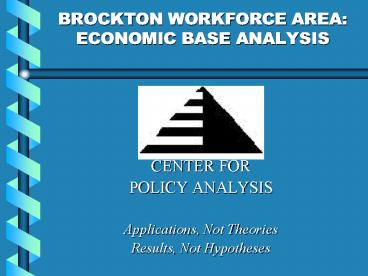BROCKTON WORKFORCE AREA: ECONOMIC BASE ANALYSIS - PowerPoint PPT Presentation
1 / 30
Title:
BROCKTON WORKFORCE AREA: ECONOMIC BASE ANALYSIS
Description:
AVON. BRIDGEWATER. BROCKTON. E.BRIDGEWATER. EASTON. HANSON. STOUGHTON. W.BRIDGEWATER. WHITMAN ... The Workforce Investment Board should adopt a multi-tiered strategy: ... – PowerPoint PPT presentation
Number of Views:77
Avg rating:3.0/5.0
Title: BROCKTON WORKFORCE AREA: ECONOMIC BASE ANALYSIS
1
BROCKTON WORKFORCE AREAECONOMIC BASE ANALYSIS
- CENTER FOR
- POLICY ANALYSIS
- Applications, Not Theories
- Results, Not Hypotheses
2
GREATER BROCKTON WORKFORCE INVESTMENT AREA
- ABINGTON
- AVON
- BRIDGEWATER
- BROCKTON
- E.BRIDGEWATER
- EASTON
- HANSON
- STOUGHTON
- W.BRIDGEWATER
- WHITMAN
3
BROCKTON WORKFORCE AREAPOPULATION 230,970
4
BROCKTON WORKFORCE AREAHISTORICAL POPULATION
5
BROCKTON WORKFORCE AREARACE ETHNICITY (2000)
6
BROCKTON WORKFORCE AREAEDUCATIONAL ATTAINMENT
(1990)
7
BROCKTON WORKFORCE AREAAGE OF RESIDENTS (2000)
8
BROCKTON WORKFORCE AREABRAIN DRAIN ( 1990 TO
2000)
9
BROCKTON WORKFORCE AREABRAIN DRAIN (1990 TO
2000)
10
GREATER WORKFORCE AREA ECONOMIC BASE ANALYSIS
Total Employment 93,079 (1999)
11
BROKCTON WORKFORCE AREAECONOMIC BASE ANALYSIS
- ANNUAL AVERAGE WAGES
- GB WIA 32,510
- MASS 40,355
12
BROCKTON WORKFORCE AREAECONOMIC BASE ANALYSIS
13
BROCKTON WORKFORCE AREAECONOMIC BASE ANALYSIS
14
BROCKTON WORKFORCE AREAECONOMIC BASE ANALYSIS
15
BROCKTON WORKFORCE AREAECONOMIC BASE ANALYSIS
CLUSTERS
- CRITICAL AND EMERGING (3 GROWTH)
- EMERGING (SUBSTANTIAL GROWTH)
- CRITICAL AND DECLINING (3 JOB LOSS)
- DECLINING (
16
BROCKTON WORKFORCE AREA ECONOMIC BASE ANALYSIS
- CRITICAL AND EMERGING
- RETAIL TRADE (25.5)
- ALLIED HEALTH SERVICES (12.9)
- DISTRIBUTION (12.3)
- CONSTRUCTION (6.8)
- BUSINESS SERVICES (4.4)
- PROFESSIONAL SERVICES (3.2)
17
BROCKTON WORKFORCE AREAECONOMIC BASE ANALYSIS
- EMERGING
- SOCIAL SERVICES (2.5)
18
BROCKTON WORKFORCE AREA ECONOMIC BASE ANALYSIS
- CRITICAL AND DECLINING
- HIGH TECHNOLOGY (3.6)
- METALS MFG (3.6)
- FINANCIAL SERVICES (3.0)
19
BROCKTON WORKFORCE AREAECONOMIC BASE ANALYSIS
20
EMPLOYMENT GAIN REAL WAGE INCREASES
- Special Trade Contractors
- Electrnc Eq. Cmponents
- Fabricated Metal Products
- Wholesale Nondurable
- Genl Merchandise Stores
- Furniture
- Dentist Offices Clinics
- Medical and Dental Labs
- Home Health Care
- Non-Depository Institutions
- Real Estate
- Eng., Accting, Res., Mgt.
- Individual Family Srvces
- Mailing, Reproduction, Stenography
21
(No Transcript)
22
(No Transcript)
23
HIGH GROWTH OCCUPATIONS EDUCATIONAL
REQUIREMENTS
24
GUIDING PRINCIPLES 1
- The Workforce Investment Board should adopt a
multi-tiered strategy - To move individuals into the labor force
(welfare-to-work school to work) - To provide short-term training that moves
unskilled workers into low-skill occupations - To provide selected educational opportunities
that help low-skill workers move up the career
ladder
25
GUIDING PRINCIPLES 2
- The Workforce Investment Board should target
much of - its limited funding on programs that develop
basic - skills and occupational competencies at the
bottom of - the educational attainment ladder. These
programs - should include, but not be limited to
- English as a Second Language (E.S.L.)
- Adult Basic Education (A.B.E.)
- Resume, Job Application, and Interview Skills
- Basic Keyboard and Computer Literacy Skills
- G.E.D.
26
GUIDING PRINCIPLES 3
- The Workforce Investment Board should target
vocational and job - training funds at short-term certification
programs in occupations - with high levels of new job growth and where
average wages are - at least 25 percent above the current
minimum wage (17,000) - Social/Human Srv Asst (24,852) Home Health
Aides (23,035) - General Office Clerks (24,638) Pers/Home Care
Aids (21,552) - Nurses Aides/Orderlies (24,327) Cashier
(19,750) - Truck Drivers, Light (23,610) Teacher Aides
(17,247) - Reception Clerks (23,490)
27
GUIDING PRINCIPLES 4
The Workforce Investment Board should use
its limited funding to leverage and coordinate
additional funds, where possible, around the
WIBs workforce development strategy. This
strategy could include sponsoring and funding
its own programs with minimal charge to
recipients, seeking additional sources of
funding from the Massachusetts Department of
Education (A.B.E., G.E.D.), the Massachusetts
Department of Transitional Assistance, and
private foundations, fund full or partial
scholarships (individual training accounts) for
short-term certification programs, especially
those that leverage additional funds from
existing vendors or providers such as the public
schools, colleges, and universities, and local
non-profit or for-profit vendors, temporary
wage subsidies for transitional assistance
recipients and the chronically unemployed while
receiving employer-provided on-the-job training.
28
WORKFORCE DEVELOPMENT PARTNERSHIPS
PUBLIC SCHOOLS
PRIVATE EMPLOYERS
STATE FEDERAL PROGRAMS
WORKFORCE INVESTMENT BOARD
4-YR COLLEGES UNIVERSITY
NON-PROFIT FOR-PROFIT TRAINING VENDORS
COMMUNITY COLLEGE
29
GUIDING PRINCIPLES 5
The Workforce Investment Board should
continue to strengthen the federal
School-to-Career Initiatives by insuring that
public school teachers and program coordinators
receive appropriate training for their role in
the area workforce development system.
30
BROCKTON WORKFORCE AREAECONOMIC BASE ANALYSIS
- WWW.UMASSD.EDU/CFPA/DOECONOMICS.HTML































